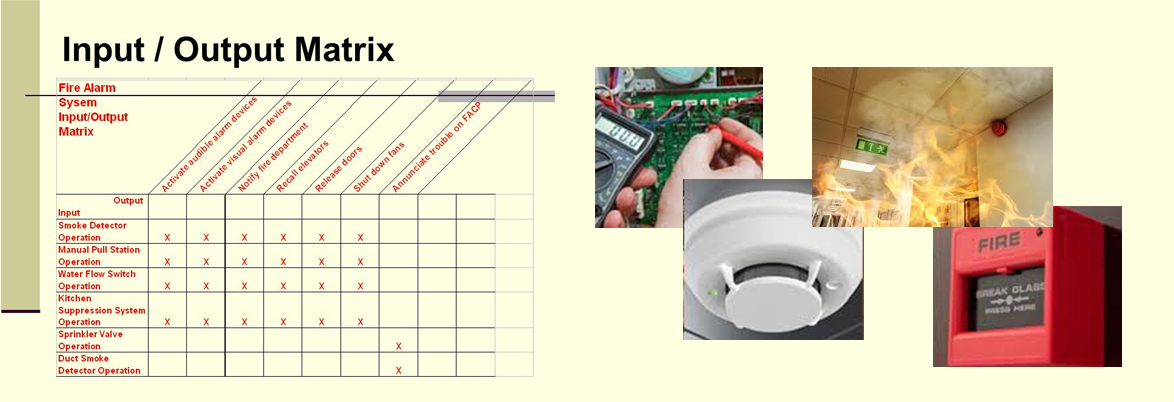Fire Alarm System Testing, Inspection and Maintenance

By alerting customers, staffs, and the public of fire condition and the need to evacuate fire alarm systems have been proven to save lives and to alert first responders quickly to prevent the spread of fire. Proper testing, inspection, and maintenance you can keep your fire alarm system at optimum operating performance.. In addition, keeping your system in good condition reduces expenses by preventing unbudgeted emergency repairs and costly/disruptive false alarms.
Steps for checking and maintaining fire alarms are well documented in NFPA and other codes. However, communicating these steps can be difficult.
First step.
Knowing the system’s age and maintenance history helps you determine the steps you must take to maintain its operational readiness. Systems under five years old should require little effort to maintain. In systems so young, problems are usually due to marginal installation like improper grounding or environmental factors like voltage issues. Periodic system testing and inspection by qualified specialists can detect many such problems. Systems between five and ten years old may experience component breakdown caused by harsh, but normal, environmental factors. Voltage fluctuations, temperature, and humidity may cause system failure or nuisance alarm problems. Systems between ten and fifteen years old can still provide appropriate life-safety response. However, systems in this category need close attention, even with proper maintenance procedures in place. If the system has had a history of poor maintenance or none at all, it’s likely that failure of components and improper monitoring of system components will occur.
Systems approaching 20 years of age may be beyond their technological life expectancy. The system may continue to work satisfactorily if properly maintained, but you need testing and inspection by trained specialists to ensure proper system response will occur in an emergency.
The steps. Some of the maintenance activities for fire alarm systems are:
- Test and calibrate input deviscd, such as flame and smoke detectors, per manufacturer specifications. This requires knowing about the different sensors—and their testing requirements, failure modes, and replacement compatibility.
- Simulate inputs and test the outputs to such things as BMS, Elevator recall, HVAC etc. This requires specific knowledge of the system under test.
-
Adjust, clean and check sensitivity’s of input devices like smoke detectors. This requires an understanding of the particular system, the specific application, and fire detection theory.
- Communicate with Central Monitoring or Civil Defense to test the proper monitoring of fire alarm systems.
- Check the battery for corrosion and expiration date, then take appropriate action, if necessary.
These steps seem simple enough, provided you have the knowledge. However, that knowledge is useless if you don’t pay attention to detail. Experience shows that maintenance technicians under pressure to keep production equipment running often overlook important details because a system is “nomal”
Standards and guidelines. Most system manufacturers recommend at least one full annual test and inspection after initial installation and acceptance. Qatar Civil Defense, , mandate, testing intervals as a minimum per NFPA-72 or corresponding NFPA if Facility or hazard is covered under specific NFPA.
System maintenance. In addition to system age, you must consider budget and staffing resources. Does your staff have the time and expertise to properly maintain this critical life-safety system? Will it be more cost-effective to have the manufacturer’s service organization or a contractor specializing in fire alarms perform the maintenance? The most stringent standards and guidelines are meaningless unless the people performing the inspection, testing, and maintenance are knowledgeable and qualified to service the fire alarm system.
Facility maintenance people usually don’t possess the experience and knowledge found in manufacturer’s service technicians, whose daily work revolves around fire alarm system technology in a variety of environments and circumstances. Some facilities have answered this problem by sending their people to factory-sponsored training courses. This approach works, if done on an ongoing basis.
You can get around the training dilemma by using a factory service agreement. These can range from a basic on-call agreement to regularly scheduled service visits. Emergency service offering four-hour and eight-hour response times, on a 24-hr-a-day basis, is an option available in most service agreements. This service usually provides response within the specified time, along with repair and replacement of equipment. Rapid emergency response is almost universal for the healthcare and lodging industries because of around-the-clock occupancy by staff, patients, and guests.
For most facilities, contracting out that function makes sense. Before you sign a maintenance agreement, though, ensure technicians are trained certified by a manufacturer or equivalent in the installation and life cycle inspection, testing, and maintenance protocols.
The best-designed fire alarm system can be rendered ineffective, if improperly maintained. Each month, NFPA members read about fire catastrophes that a well-maintained system would have prevented. They also read about fires where properly functioning systems saved lives and reduced the business interruption. When you’re limited by budgets, it’s tempting to take the risk that a fire won’t happen and delay responsible decisions about your fire protection until the next quarter. However, courts have increasingly ruled against people who have made such decisions, and held them—and their managers—personally and criminally liable as in high profile cases in Qatar involving malls, petrol station explosions/fires and construction site issue. You must ensure your fire protection system operates properly as this will save lives, assets and money in the long run.
